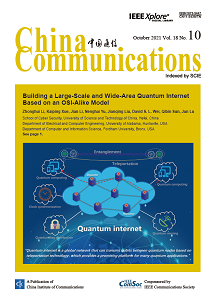工业物联网混合云雾网络低时延低功耗路径计算方案
IF 3.1
3区 计算机科学
Q2 TELECOMMUNICATIONS
引用次数: 0
摘要
随着工业物联网(IIoT)的快速发展,传统的集中式云处理模式在处理工业大数据任务时遇到了高通信延迟和高能耗的挑战。针对上述问题,本文提出了一种低时延、低能耗的路径计算方案。该方案基于云雾网络架构。在从工业现场设备到云中心的数据交互过程中,利用雾计算层中雾网络设备的计算资源,逐步完成任务处理。为了将制造任务合理地部署到雾计算层,提出了一种基于粒子多样性离散二进制粒子群优化(PDBPSO)算法的协同调度策略。将有向无环图(DAG)形式的任务映射到无向图(UG)形式的工厂雾网络,为任务找到合适的计算路径,显著降低了能耗约束下的任务处理延迟。仿真实验表明,该方案的延迟性能优于将任务完全卸载到云的策略和将任务全部卸载到边缘设备的策略。本文章由计算机程序翻译,如有差异,请以英文原文为准。
Path computing scheme with low-latency and low-power in hybrid cloud-fog network for IIoT
With the rapid development of the Industrial Internet of Things (IIoT), the traditional centralized cloud processing model has encountered the challenges of high communication latency and high energy consumption in handling industrial big data tasks. This paper aims to propose a low-latency and low-energy path computing scheme for the above problems. This scheme is based on the cloud-fog network architecture. The computing resources of fog network devices in the fog computing layer are used to complete task processing step by step during the data interaction from industrial field devices to the cloud center. A collaborative scheduling strategy based on the particle diversity discrete binary particle swarm optimization (PDBPSO) algorithm is proposed to deploy manufacturing tasks to the fog computing layer reasonably. The task in the form of a directed acyclic graph (DAG) is mapped to a factory fog network in the form of an undirected graph (UG) to find the appropriate computing path for the task, significantly reducing the task processing latency under energy consumption constraints. Simulation experiments show that this scheme's latency performance outperforms the strategy that tasks are wholly offloaded to the cloud and the strategy that tasks are entirely offloaded to the edge equipment.
求助全文
通过发布文献求助,成功后即可免费获取论文全文。
去求助
来源期刊

China Communications
工程技术-电信学
CiteScore
8.00
自引率
12.20%
发文量
2868
审稿时长
8.6 months
期刊介绍:
China Communications (ISSN 1673-5447) is an English-language monthly journal cosponsored by the China Institute of Communications (CIC) and IEEE Communications Society (IEEE ComSoc). It is aimed at readers in industry, universities, research and development organizations, and government agencies in the field of Information and Communications Technologies (ICTs) worldwide.
The journal's main objective is to promote academic exchange in the ICTs sector and publish high-quality papers to contribute to the global ICTs industry. It provides instant access to the latest articles and papers, presenting leading-edge research achievements, tutorial overviews, and descriptions of significant practical applications of technology.
China Communications has been indexed in SCIE (Science Citation Index-Expanded) since January 2007. Additionally, all articles have been available in the IEEE Xplore digital library since January 2013.
 求助内容:
求助内容: 应助结果提醒方式:
应助结果提醒方式:


